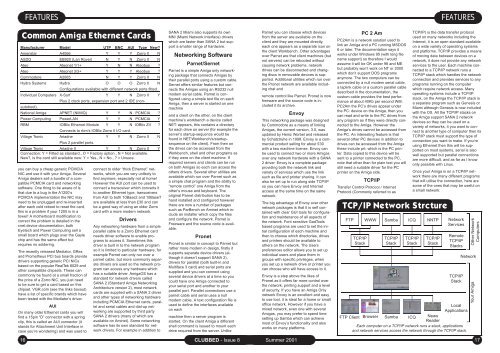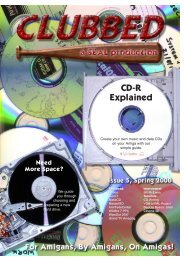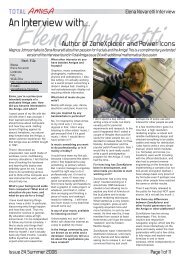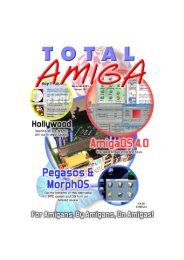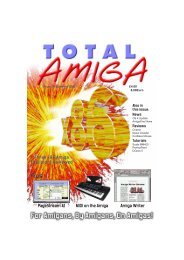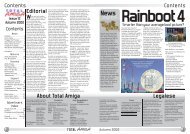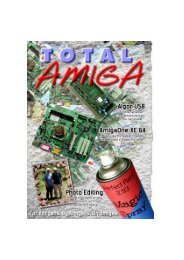14FEATURESNetworkingGetting computers to communicate can be tough butthe results are worth it. Robert Williams gets stuck in.Many people now have severalcomputers, some have acollection of <strong>Amiga</strong>s andothers a mixed bag of different platforms.If you have more than onemachine it is useful to be able to moveinformation between them, for smallamounts of data or occasional useswapping floppies, ZIP disks or CD-RWsis probably fine. If you want to move informationaround on a regular basis anetwork makes life much easier andsome types of network also offer thepossibility of sharing other resourcessuch as an internet connection or printersbetween machines as well assimply files.Most networks consist of three discreetparts (I’m simplifying here but the threeelements I describe are the ones a userhas to think about) , the hardware whichphysically links the computers together,the networking software which allowsthem to communicate and applicationsoftware which actually uses the networkconnection. On many simpler networksthe networking software is alsothe application software, it establishescommunication and includes variousservices such as file transfer. More complexnetworks use networking softwaresuch as a TCP/IP stack to enable communicationthen separate applicationsoftware like a web browser or FTPclient uses this connection to send andreceive data across the network. In thisfeature I will look at each of theseelements in turn.HardwareSerialProbably the lowest cost and simplestway to connect two computers is viatheir serial ports, the vast majority ofcomputers have a serial port complyingto the RS232 standard and thereforecan be connected in this way. To makethis connection you need a null modemserial cable which is a standard cableavailable at most computer shops andsuppliers such as Maplin Electronics.Note that a null modem cable is not thesame as the cable used to connect amodem or other serial equipment.<strong>Amiga</strong>s have a 25 pin “D” serial portwhere as most recent PCs (and someother machines) have a 9 pin “D” portboth these ports have the same connectionsso all you need is a null modemcable with the appropriate connectors,you can also buy adaptors from a 25 toa 9 pin port and vice versa. Two types ofnull modem cable are available, threewire and seven wire, the advantage of aseven wire cable is that you can usehardware flow control (also calledRTS/CTS flow control). With a three wirecable (send, receive and ground) codes(called Xon/Xoff) within the data streamare used by each machine to tell theother when it has data to send and whenit is ready to receive data. A seven wirecable has Ready to Send and Clear toSend lines allowing the flow of data tobe controlled through hard ware whichimproves performance and reliability.The maximum length for a good qualityseven wire null modem cable is about15 meters, longer lengths may work butyou are more likely to encounter errorsas the length increases.There are two main limitations to a serialconnection, firstly it is a point to pointconnection, unless you have machineswith multiple free serial ports you canonly link two machines at a time. Thesecond limitation is that serial transfersare slow, the maximum speed of the<strong>Amiga</strong>’s internal serial port is 115200B/s(bits per second) which equates to about14kb/s (kilo bytes per second) beforeany network overhead is taken into account,this is much slower than even afloppy disk drive, transferring a 1Mb filewould take about 1.5 minutes over thisconnection.A serial connection is a cheap way toconnect two computers of almost anytype however it is only really suitable forsmall amounts of data or occasionallytransferring large amounts when you’reprepared to wait.ExplainedParallelWhile the parallel port wasn’t reallydesigned with networking in mind (manyearly personal computers had a parallelport that could only send data) there areseveral systems available which allowyou to link two <strong>Amiga</strong>s or an <strong>Amiga</strong> anda PC using this port. All systems usingthe parallel port use a custom parallelcable such as a ParNET cable (this wasoriginally designed for use with ParNETbut is now also used by other parallelnetworking software such as ProNET) ora laplink cable (also called a “null printer”cable). Never connect the parallelports of two computers using a straightthrough cable as this can causedamage, always ensure you are using acable wired for parallel networking.A parallel connection is usually considerablyfaster than a serial connectionat about 40-60kb/s meaning our 1Mb filewould transfer in around 20 seconds.Cable length is limited to about 5m,again you may be able to get away witha longer cable but you risk data corruption.As the parallel port is implementeddifferently on different computers andoperating systems parallel networking isnot as universal as serial, there tends tobe a specific software and cable com-Network TopologiesHUBPoint to Point:Two devicesdirectly connected.Chain:Each device isconnected to thenext making aingle chain.Star:Each device isconnected to acentral hub.CLUBBED - Issue 8bination required to link to your <strong>Amiga</strong> toeach other platform.If you have two machines which supportparallel networking and are locatedclose together then it is considerablyfaster than serial.EthernetEthernet is the most common dedicatednetworking standard, you will find it inmost companies, businesses, homesand schools connecting anything fromtwo to thousands of computers. Thereare various types of Ethernet identifiedby their speed (in Megabits per second)and the type of cable used to connectthe devices (usually computers but youcan also connect some printers,cable/ADSL modems and various networkdevices directly to an Ethernet network)on the network. Each device isconnected to the network, if the computeror device does not have anEthernet port built in then a NetworkInterface Card (NIC) has to be added.There are two common layouts (alsocalled topologies) for an Ethernet network,a star or a chain. In a star topologyeach device is connected to a centralhub, when one device sends amessage the hub then broadcasts themessage to all the connected devices,for this reason hubs are sometimescalled repeaters or concentrators. Withthe chain topology each device is connectedto another forming a daisy chain,as all the devices are connected to thesame cable a message sent by onedevice is seen by all the others withoutthe need for a hub. A chain topology isusually cheaper to set up because itdoes not require a hub and generallyneeds less cable however it has the disadvantagethat disconnecting onedevice from the network breaks thechain and stops some devices accessingthe rest of the network until the chainis restored. On a star network eachdevice is independent of all the othersand can be disconnected at will. In largenetworks a star based topology haseven more advantages because it iseasier to troubleshoot and expand butthis is beyond the scope of this feature.So let’s take a look at the various typesof Ethernet network available to the<strong>Amiga</strong> user, in this section I will onlymention the most common types used inhome and small business networking.10BaseTA 10BaseT Ethernet network runs at10MB/s (just over 1 Megabyte persecond) using Unshielded Twisted Pair(UTP) cables and must use a star networktopology if there are more than twonetwork devices. UTP cables have eightwires arranged as four pairs twistedtogether which helps reduce interference,removing the need for anyshielding. RJ45 connectors (similar totelephone connectors) are used to connectthe UTP cable to each device. Twodevices can be connected directly usinga UTP cross over cable (the send andreceive lines are crossed) but if morethan two devices need to be connectedthen a hub must be used, devices areconnected to the hub using patch cableswhich are connected straight through(not crossed). 10BaseT hubs start ataround £20 for a unit with 4 UTP ports,much larger ones are available and hubscan be cascaded (by linking one toanother) up to 4 deep. 10BaseTEthernet networks are by far the mostpopular and you will find that suitablehardware is very readily and cheaplyavailable, most current computers (bethey PCs, Macs, Unix boxes etc.) comewith at least a 10BaseT NIC built in, andif not PCI NICs are available verycheaply (from about £10).10Base2A 10Base2 network also runs at 10MB/sbut uses 58 ohm coaxial cable (similar inconstruction to a TV aerial lead) whichconnects to each device using a BNCconnector (this is a coaxial connectorwith a locking ring to prevent accidentaldisconnection). A 10Base2 networkmust use the chain topology with eachmachine connected to another. To dothis each device has a “T” adaptor connectedto its BNC connector and a cableto another machine on the chain is connectedto each “arm” of the “T”. On thedevice at the each end of the chain a50ohm terminator must be connected tothe empty leg of the “T” adaptor, theseterminators are required even if thereare only two machines on the network.For the reasons set out in the sectionabove 10Base2 networks are becomingless popular and 10BaseT (and fastersystems based on the same type of cabling)now dominate the market.However many older Ethernet cardsonly have a BNC connector for10Base2, if you would like to connectthis type of card to a 10BaseT networkmany hubs are available with UTP portsand a BNC connector which can beused to hook up one or more deviceswith 10Base2 connections chainedtogether.FEATURES100BaseT and 1000BaseT(GigaBit)100BaseT and 1000BaseT (alsoreferred to as Gigabit Ethernet) arefaster Ethernet implementations whichtransfer date at 100MB/s and 1000MB/srespectively using UTP cables. To myknowledge no Ethernet cards supportingthese standards have ever beenreleased for the <strong>Amiga</strong>. While 10BaseTis still by far the most common standard100BaseT is becoming more popularwhile 1000BaseT is still very rare outsideserver installations. Many Ethernetdevices capable of 100MB/s operationalso support 10MB/s and are commonlylabelled 10/100, however if you connecta 10MB device to a 100MB network thewhole network has to slow down to thespeed of the slower device.SwitchesOne way to avoid slowing down a100MB network when you add a 10MBdevice is to use a 10/100MB switch insteadof a hub. A switch is similar to ahub in that network devices connect to itin a star topology but instead of broadcastingeach packet of data to everydevice on the network a switch examinesthe packet and only sends it tothe device it is intended for. This allowseach device on the network to run at itsmaximum speed as it is effectively talkingdirectly to one other device at a time.This is really only a side effect of aswitch as its main purpose is to reducenetwork congestion and to allow alldevices to run full duplex (they can sendand receive at the same time) whichalso improves performance.You’re NICedEthernet Network Interface cards havebeen made for almost every model of<strong>Amiga</strong> (yes, even the A500!), if you havea machine with Zorro slots quite a widevariety of Zorro II Ethernet cards havebeen available and one or two can stillbe found new (see table on the nextpage). As usual the Zorro cards tend tobe fairly expensive this means thatsecond hand prices have also remainedquite high. If you’re looking to buysecond hand be aware that many olderZorro cards do not have a UTP connectorso you’ll need to make sure theycan be integrated into your network.A1200 and A600 users can get aPCMCIA Ethernet card, a freewaredriver called cnet.device exists whichsupports a variety of cards which complywith the NE2000 standard, this meansSummer 2001 15
FEATURESFEATURES<strong>Amiga</strong> Ethernet CardsCommon <strong>Amiga</strong> Ethernet CardsManufacturer Model UTP BNC AUI Type New?Ameristar A4066 Y Y Y Zorro II NASDG EB920 (Lan Rover) N Y N Zorro II NAteo Ateonet 1/1+ Y N N Ateobus ?Ateo Ateonet 3/3+ Y Y Y Ateobus ?Commodore A2065 N Y Y Zorro II NHydra Systems Hydra O O O Zorro II NConfigurations available with different network ports fitted.Individual Computers X-Surf Y Y N Zorro II YPlus 2 clock ports, expansion port and 2 IDE (nonautoboot).National <strong>Amiga</strong> APNET (NIMIQ) Y Y N PCMCIA ?Power Computing PowerLAN Y Y N PCMCIA YRBM IOBlix Ethernet Module Y Y N IOBlix ZII ?Connects to rbm’s IOBlix Zorro II I/O card.Village Tronic Ariadne Y Y N Zorro II NPlus 2 parallel ports.Village Tronic Ariadne II Y Y N Zorro II YConnection: Y = Fitted as standard., O = Factory option., N = Not available.New?, is the card still available new: Y = Yes., N = No., ? = Unsure.you can buy a cheap generic PCMCIANIC and use it with your <strong>Amiga</strong>. Several<strong>Amiga</strong> dealers sell a bundle of a compatiblePCMCIA card and networkingsoftware. One thing to be aware of isthat due to a bug in the A1200’sPCMCIA implementation the NIC mayneed to be unplugged and re-insertedafter each cold reboot to reset the card,this is a problem if your 1200 is in atower! A motherboard modification tocorrect the problem is detailed in thecnet.device documentation, bothEyetech and Power Computing sell asmall board which plugs over the Gaylechip and has the same effect butrequires no soldering.The recently released Mediator, GRexand Prometheus PCI bus boards providedrivers supporting generic PCI NICsbased on the popular RealTek 8029 andother compatible chipsets. These cancommonly be found at a small fraction ofthe price of a Zorro NIC, you just needto be sure to get a card based on thischipset. VGR.com (see the links boxout)have a list of specific brands which havebeen tested with the Mediator’s driver.AUIOn many older Ethernet cards you willfind a 15pin “D” connector with a springclip, this is called an AUI connector (itstands for Attachment Unit Interface incase you’re wondering) and was used toconnect to older “thick Ethernet” networks,which you are very unlikely tofind anymore, especially not at home!However the AUI port can be used toconnect a transceiver which converts itto another Ethernet type, transceiversfrom AUI to both 10Base2 and 10BaseTare available at less than £30 and canbe a good way of using an older Zorrocard with a more modern network.DriversAny networking hardware from a simpleparallel cable to a Zorro Ethernet cardneeds driver software to enable programsto access it. Sometimes thisdriver is built in to the network programso it is limited to particular hardware, forexample Parnet can only run over aparnet cable, but more commonly separatedrivers are used so the network programcan access any hardware whichhas a suitable driver. <strong>Amiga</strong>OS has astandard for network drivers calledSANA 2 (Standard <strong>Amiga</strong> NetworkingArchitecture version 2), most networkcards are supplied with a SANA 2 driverand other types of networking hardwareincluding PCMCIA Ethernet cards, paralleland serial cables and dial-up networkingare supported by third partySANA 2 drivers (many of which areavailable on Aminet). Some networkingsoftware has its own standard for networkdrivers. For example in addition toSANA 2 Miami also supports its ownMNI (Miami Network Interface) driverswhich are faster than SANA 2 but supporta smaller range of hardware.Networking SoftwareParnet/SernetParnet is a simple <strong>Amiga</strong> only networkingpackage that connects <strong>Amiga</strong>s bytheir parallel ports using a custom cable.Sernet offers similar features but connectsthe <strong>Amiga</strong>s using an RS232 nullmodem serial cable. Parnet is configuredusing a simple text file on each<strong>Amiga</strong>, then a server is started on onemachineand a client on the other, on the clientmachine’s workbench a device calledNET: appears, this contains a directoryfor each drive on server (for example theserver’s startup-sequence would befound in NET:Workbench/s/startupsequenceon the client). From then onthe drives can be accessed from theWorkbench, shell and other programs asif they were on the client machine. Ifrequired servers and clients can be runon both <strong>Amiga</strong>s so each can access theothers drivers. Several other utilities areavailable which run over Parnet such asa simple chat program and the ability to“remote control” one <strong>Amiga</strong> from theother’s mouse and keyboard. Theoriginal Parnet distribution has to behand installed and configured howeverthere are now a number of packagessuch as ParBench on Aminet which includean installer which copy the filesand configure the network. Parnet isFreeware and the source code is available.PronetPronet is similar in concept to Parnet butrather more modern in design, firstly itsupports separate device drivers (althoughit doesn’t support SANA 2),drivers for parallel (both built-in andMultiface 3 card) and serial ports aresupplied and you can connect usingseveral device drivers at a time so youcould have one <strong>Amiga</strong> connected toyour serial port and another to yourparallel port. Parallel connections use aparnet cable and serial uses a nullmodem cable. A text configuration file isused to define the interfaces availableon eachmachine then a server program isstarted. On the client <strong>Amiga</strong> a differentshell command is <strong>issue</strong>d to mount eachdrive required from the server. UnlikeParnet you can choose which devicesfrom the server are available on theclient and they are mounted directly,each one appears as a separate icon onthe client Workbench. Other advantagesover Parnet are that client machines (butnot servers) can be rebooted withoutcausing network problems, networkdrives can be disconnected and changingdiscs in removable devices is supported.Additional utilities which run overthe Pronet network are available includingchat andremote control like Parnet. Pronet is nowfreeware and the source code is includedit its archive.EnvoyThis networking package was designedby Commodore as a means of linking<strong>Amiga</strong>s, the current version, 3.0, wasupdated by Heinz Worbel and releasedby Schatztruhe in 1998. Envoy is a commercialproduct selling for about £30with a two machine license. Envoy canbe used to connect two or more <strong>Amiga</strong>sover any network hardware with a SANA2 driver. Envoy is a complete packageproviding both the network link andvariety of services which use the linksuch as file and printer sharing. It canalso be set up to run along side TCP/IPso you can have Envoy and Internetaccess at the same time on the samenetwork.The big advantage of Envoy over othernetwork packages is that it is self containedwith clear GUI tools for configurationand maintenance of all aspects ofthe network. Font sensitive GadToolsbased programs are used to set the initialconfiguration of each machine andthen to choose which directories, drivesand printers should be available toothers on the network. The Userspreferences editor allows you to set upindividual users and place them ingroups with specific privileges, whenyou set up a network drive or printer youcan choose who will have access to it.Envoy is a step above the likes ofPronet as it offers far more control overthe network, printing support and a levelof security. If you have an <strong>Amiga</strong> Onlynetwork Envoy is an excellent and easyto use tool, it is ideal for a home or smalloffice network. However if you have amixed network, even one with several<strong>Amiga</strong>s, you may prefer to spend timesetting up Samba which can achievemost of Envoy’s functionality and alsoworks on many platforms.PC 2 AmPC2Am is a network solution used tolink an <strong>Amiga</strong> and a PC running MSDOS6 or later. The documentation says itworks under Windows 95 (with long filename support) so therefore I wouldassume it will be OK under 98 and MEbut probably won’t work on NT or 2000which don’t support DOS programsanymore. The two computers can beconnected by a null modem serial cable,a laplink cable or a custom parallel cabledescribed in the documentation, thecustom cable provides the best performanceat about 40Kb per second WithPC2Am the PC’s drives appear underthe PC: device on the <strong>Amiga</strong>, then youcan read and write to the PC drives fromany program as if they were directly connectedto the <strong>Amiga</strong>. However the<strong>Amiga</strong>’s drives cannot be accessed fromthe PC. An interesting feature is thatseveral other PC devices in addition todrives can be accessed from the <strong>Amiga</strong>these include prt: which is the PC printer.Data copied to this device will besent to a printer connected to the PC,note that other than for plain text you willstill need a suitable driver for the PCprinter on the <strong>Amiga</strong> side.TCP/IPTransfer Control Protocol / InternetProtocol (Commonly referred to asTCP/IP) is the data transfer protocolused on many networks including theInternet, it is an open standard availableon a wide variety of operating systemsand platforms. TCP/IP provides a meansof moving data between devices on anetwork, it does not provide any networkservices to the user. Each machine connectedto a TCP/IP network runs aTCP/IP stack which handles the networkconnection and provides services to anyprograms running on the computerwhich require network access. Manyoperating systems include a TCP/IPstack, on the <strong>Amiga</strong> the TCP/IP stack isa separate program such as Genesis orMiami although Genesis is now includedwith the OS. All the TCP/IP stacks onthe <strong>Amiga</strong> support SANA 2 networkdevices so they can be used on avariety of networks, it you want to connectto another type of computer then itsTCP/IP stack must support the type ofconnection you want to make. If you’reusing Ethernet then this will be supportedon most systems, serial is alsowell supported but parallel connectionsare more difficult, and as far as I knowonly possible with Linux.Once your <strong>Amiga</strong> is on a TCP/IP networkthere are many different programsthat will utilise the connection, here aresome of the ones that may be useful ona small network:TCP/IP Network StrctureFTP WWW Samba ICQ NNTP NetworkServicesTCP/IPStackTCP/IPStackTCP/IPStackTCP/IPStackRemoteTCP/IPStacksTCP/IPStackNetworkLocalApplicationsFTP Client Browser Samba ICQ NewsReaderEach computer on a TCP/IP network runs a stack, applicationsand network services access the network through the TCP/IP stack.Other NetworkComputersYour <strong>Amiga</strong>16 CLUBBED - Issue 8Summer 200117


